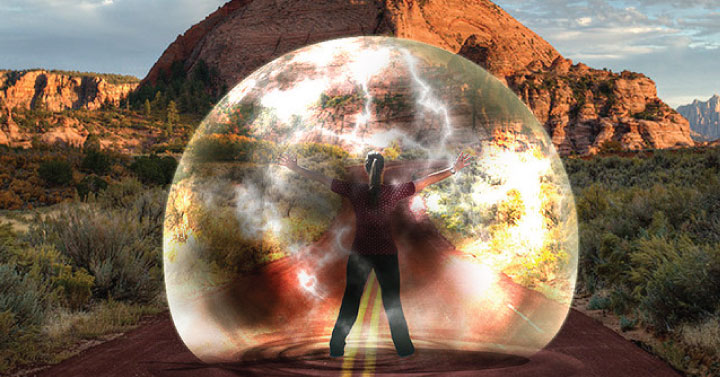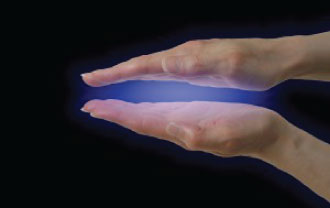
Have you ever felt a force field around your body?
Our brains are aware not just of our bodies but also the immediate space around us. Now, a twist on the classic rubber hand illusion can make people “feel” this space – a sensation they liken to perceiving a Force Field.
Neuroscientists have known for decades that our brains contain representations of the area surrounding us, known as peripersonal space. This allows us to grasp objects within our reach and helps to protect us.
Imagine you are walking through the woods talking to a companion, when a low-hanging branch suddenly appears in your peripheral vision. You’ll instinctively duck to avoid it: your sense of peripersonal space has prevented you from banging your head.
Hard neuroscientific evidence on the phenomenon appeared in the late 1990s in animal studies. Michael Graziano of Princeton University, New Jersey, and his colleagues recorded the electrical activity of neurons in the parietal and frontal lobes of the brains of monkeys, finding that some neurons fired not only when an object touched part of the body, but also when the object came near it.
Recommended: What Is Aura
When the researchers directly stimulated such neurons, they found that the monkeys would reflexively move their heads and limbs as if defending themselves – for example, grimacing and closing their eyes, turning their heads to one side and putting up their arms in a protective posture.

Although no one has repeated the experiments in humans, there is evidence that certain regions of our brain specifically deal with peripersonal space.
For instance, some people who suffer strokes in the right posterior parietal lobe cannot sense peripersonal stimuli on the left side of their bodies, but can sense things that are further away, outside the peripersonal space on that side.
Sensory Trick
At least, that’s the theory. Now, Guterstam and his colleagues have tricked humans into actually feeling our peripersonal space.
To do so, they turned to the well-known rubber hand illusion. In the standard form of this illusion, the experimenter uses a paintbrush to stroke a volunteer’s hand (which is hidden from view) and an adjacent, visible rubber hand.
The stroking is done simultaneously at the same speed and place on both the real and rubber hand. Within minutes, most people report feeling the touch of the brushstrokes on the rubber hand as if it belonged to them.
Researchers noticed that the illusion didn’t work if the rubber hand was too far away from the real hand.
In the new study, which involved 101 adults, the researchers made one important change to the experiment. They never brushed the rubber hand directly. Instead, they moved the brush above the rubber hand, again at the same time as brushstrokes that touched the real hand.
Recommended: 5 Easy Steps to Start Seeing The Aura
This meant the volunteer felt touch on their real hand but watched the brush move in mid-air, say, about 10 centimetres above the rubber hand.
Most volunteers reported feeling a Magnetic Force or Force Field between the paintbrush and the rubber hand below – as if the brush was encountering an invisible barrier.“We can elicit this bizarre sensation of there actually being something in mid-air between the brush and the rubber hand,” says Guterstam. The volunteers also felt a sense of ownership of the rubber hand.
The team found that the illusion disappears when the brushstrokes are more than about 30-40 centimetres above the rubber hand. This distance seems to be the limit of the peripersonal space of any given body part.
Recommended: The Seven Layers Of The Aura
The illusion of the Force Field also disappears if there is an opaque metal barrier between the rubber hand and the brush. Because the barrier makes it impossible for the hand to reach up and grasp anything, or for anything to hit the hand, the space above is now not peripersonal space, Guterstam speculates.
“This is a wonderful study,” says Graziano. “For decades, the neuroscience of the parietal and frontal lobes has filled in our knowledge of the special margin of safety, or buffer zone, around the body. Now we have a clever way to get at the phenomenon through an illusion that is easy to implement in the lab.”
The fun part about this experiment is that you can do it at home. Try it out and let us know that you think about it in the comments below.
Originally written by Anil Ananthaswamy and published on New Scientist

bestmanualpolesaw.com
아래에 경전을 가르치는 수행자가 있었지만 Hongzhi 황제의 생각은 이미 멀리 날아갔습니다.
Hey, you used to write wonderful, but the last several posts have been kinda boring… I miss your super writings. Past few posts are just a little bit out of track! come on!
Superb blog! Do you have any tips and hints for aspiring writers? I’m planning to start my own website soon but I’m a little lost on everything. Would you suggest starting with a free platform like WordPress or go for a paid option? There are so many options out there that I’m totally overwhelmed .. Any tips? Many thanks!
I am now not sure the place you’re getting your info, however great topic. I needs to spend a while finding out more or figuring out more. Thanks for excellent information I used to be in search of this information for my mission.
What¦s Taking place i am new to this, I stumbled upon this I have found It absolutely useful and it has helped me out loads. I hope to give a contribution & aid different customers like its aided me. Great job.
A person necessarily help to make severely articles I would state. That is the very first time I frequented your website page and so far? I amazed with the analysis you made to make this particular post incredible. Wonderful activity!
sandyterrace.com
Hongzhi 황제는 등 뒤로 손을 대고 고개를 저었다. “정말 존경합니다.”
fpparisshop.com
このブログはいつも私の期待を超える情報を提供してくれます。本当にありがとう。
werankcities.com
Hongzhi 황제는 약간 미소를지었습니다. “이 Jifan은 정말 진지합니다.”
Hey, you used to write excellent, but the last several posts have been kinda boring… I miss your tremendous writings. Past few posts are just a little out of track! come on!
I’ve learn some just right stuff here. Definitely price bookmarking for revisiting. I wonder how much attempt you put to create such a magnificent informative website.
PBN sites
We’ll establish a structure of privately-owned blog network sites!
Benefits of our private blog network:
We perform everything so GOOGLE does not realize THAT THIS IS A PBN network!!!
1- We acquire web domains from various registrars
2- The principal site is hosted on a VPS hosting (VPS is fast hosting)
3- Additional sites are on separate hostings
4- We designate a individual Google account to each site with confirmation in Google Search Console.
5- We make websites on WordPress, we don’t utilize plugins with assisted by which malware penetrate and through which pages on your websites are produced.
6- We refrain from repeat templates and utilize only unique text and pictures
We do not work with website design; the client, if desired, can then edit the websites to suit his wishes
Very nice post. I just stumbled upon your blog and wished to mention that I have truly loved surfing around your blog posts. After all I will be subscribing in your feed and I hope you write again soon!
otraresacamas.com
読むたびに感心します。いつも有益な情報をありがとう。
I am happy that I observed this blog, exactly the right information that I was searching for! .
Do you have a spam problem on this website; I also am a blogger, and I was wanting to know your situation; we have developed some nice methods and we are looking to trade strategies with others, be sure to shoot me an email if interested.
animehangover.com
Hongzhi 황제는 하나님 아버지를 숭배하는 명판을 올려다 보았습니다. “계속 말하십시오.”
It’s a pity you don’t have a donate button! I’d certainly donate to this superb blog! I suppose for now i’ll settle for book-marking and adding your RSS feed to my Google account. I look forward to brand new updates and will talk about this website with my Facebook group. Talk soon!
It’s really a great and helpful piece of info. I’m happy that you just shared this useful info with us. Please stay us up to date like this. Thanks for sharing.
sandyterrace.com
Hongzhi 황제가 말했듯이 그는 Xiao Jing을 침착하게 바라 보았습니다.